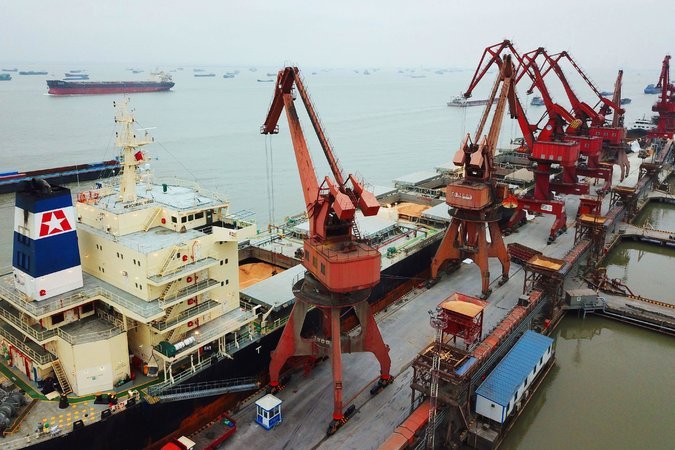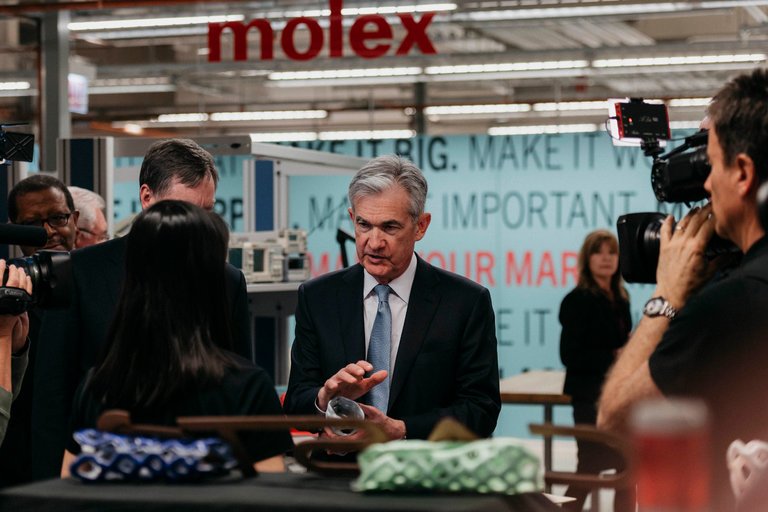Supported by
Economy
More Jobs, Faster Growth and Now, the Threat of a Trade War
The rapidly escalating trade conflict with China has upended the prevailing economic dynamic of falling unemployment and faster growth, leaving policymakers and investors scrambling to figure out the way forward.
The threat of a trade war loomed over Jerome H. Powell’s inaugural speech as Federal Reserve chairman on Friday in Chicago, even as he tried to focus attention on the fundamental strength of the American economy. Financial markets fell Friday morning after President Trump’s latest salvo against China, then tumbled further after Mr. Powell indicated that the Fed saw no imminent need to adjust its outlook. The Standard & Poor’s 500-stock index ended the day down 2.2 percent, closing a turbulent week.
And there was uncertainty in Washington, where lawmakers, lobbyists and even White House officials struggled to discern how much of Mr. Trump’s move was policy and how much was bluster.
The president acknowledged that the trade friction could take a toll. “I’m not saying there won’t be a little pain,” he said in a radio interview on Friday. “But we’re going to have a much stronger country when we’re finished.”
Advertisement
Continue reading the main story
The concern over trade was evident at Mr. Powell’s appearance before the Economic Club of Chicago. The Fed chief did not mention tariffs in his speech, but in a question-and-answer session afterward, they were the first topic raised.
Continue reading the main story
The Fed chief, who took his post in February, said it was “too early to say” what impact the dueling trade measures would have. “We don’t know the extent to which the tariffs will actually come into effect and, if so, how big will that effect be and what will the timing of it be,” Mr. Powell said. But he made it clear that the Fed would watch closely for any sign that the trade dispute was knocking the recovery off course.
The trade tensions complicate what was already a tricky task for the Fed. Hundreds of billions of dollars in tax cuts and spending increases risk fueling inflation, as do wage pressures from a robust labor market. The government’s monthly jobs report on Friday, while more subdued than in recent months, still pointed to a healthy employment picture.
Yet policymakers are wary of acting too aggressively to slow the economy at a time when wage growth has been tepid. The Fed’s response has been gradual interest-rate increases.
A trade war could act as a drag on economic growth, forcing the Fed to be even more cautious. But tariffs could also raise consumer prices by limiting cheap imports from China and other countries. That could increase the risk that the Fed will lift rates too quickly, choking off the recovery.
“There’s an immediate, knee-jerk reaction to tighten policy more,” said Ellen Zentner, chief United States economist for Morgan Stanley.
The latest escalation between the United States and China came Thursday evening, when Mr. Trump said he was considering tariffs on an additional $100 billion of Chinese imports. That came on top of the tariffs on steel and aluminum imposed last month and those on $50 billion in Chinese goods that he proposed in recent days. China has responded with its own new tariffs.
It is not clear whether Mr. Trump will make good on his latest threats. Larry Kudlow, Mr. Trump’s new top economic adviser, has sought to portray the tariffs as an opening bid in a negotiating process with China, and he told reporters on Friday that “there are all kinds of back-channel discussions going on.”
Advertisement
Continue reading the main story
But Mr. Trump’s Treasury secretary, Steven Mnuchin, indicated that tensions had reached a more combustible level. “There is the potential of a trade war,” Mr. Mnuchin said Friday on CNBC. “There is a level of risk that we could get into a trade war.”
The trade upheaval threatens to undermine an American economy that is at its strongest point since the financial crisis struck a decade ago. Employers have added jobs for 90 consecutive months, by far the longest streak on record; the unemployment rate, at 4.1 percent, is the lowest since 2000.

“The labor market has been strong, and my colleagues and I on the Federal Open Market Committee expect it to remain strong,” Mr. Powell said on Friday, referring to the Fed’s policy group.
Wage growth, weak for much of the recovery, ticked up in March, and Mr. Powell said he expected the gains to continue in the months ahead. And while workers would, without a doubt, like to see their pay rise more quickly, the gradual pace is comforting for some investors, who have been watching for any hints that the economy is overheating.
In his speech, Mr. Powell said the Fed saw “other signs of economic strength,” citing “steady income gains, rising household wealth and elevated consumer confidence,” which he said would continue to support consumer spending.
Other economists agreed, saying that the recently passed tax and spending measures give the economy added momentum. A full-blown trade war might be enough to short-circuit the recovery, they said, but isolated tariffs — even large ones — most likely are not.
Certain categories are more vulnerable. Among the retaliatory moves announced by China are new tariffs on soybeans, which could hurt American farmers already struggling with low prices for their crops.
The nation’s factories, a sector that Mr. Trump has championed, have become a bright spot in the recovery — a development Mr. Powell underlined on his Chicago visit by touring an incubator for industrial start-ups. But Mr. Trump’s tariffs could force manufacturers to pay more for materials, and China’s countermeasures could hurt their overseas sales.
Just the prospect of tariffs — even before they begin to take a direct bite — could hurt the economy if it makes corporate executives reluctant to invest.
Advertisement
Continue reading the main story
Becky Frankiewicz, president of ManpowerGroup, a staffing firm, said she was already hearing from clients that they are more hesitant to commit to major projects, at least until they see whether this week’s skirmishes develop into an all-out trade war.
“We’re not seeing the impact directly of tariffs yet, but we would say there’s pretty broad conservatism as a result,” she said.
Mr. Powell said Fed policymakers, too, were conscious of concerns from corporate executives.
“We did hear from a number of business leaders around the country that changes in trade policy had become a bit of a risk to the medium-term outlook,” Mr. Powell said in the question-and-answer session.
Continued turmoil in financial markets could begin to hurt spending, especially among higher earners, who are more likely to own stocks. Ms. Zentner said surveys suggested that some high-income consumers had already become more pessimistic as markets have become more volatile.
“It’s starting to affect those groups, whose spending is more tied to the stock market,” Ms. Zentner said. “If they simply pause their spending or become more prudent in their spending because of market volatility, it drags down consumer spending in the aggregate.”
The effect of all this on the Fed’s thinking won’t be clear until the next policy meeting on May 1 and 2. Fed officials raised interest rates by a quarter of a percentage point at their most recent meeting, in March, to a range of 1.5 percent to 1.75 percent. Officials indicated that they considered the economy and labor market healthy, and that they expected to raise rates twice more this year and three times in 2019.
Mr. Powell, like his predecessor, Janet L. Yellen, cast that gradual series of increases as a carefully planned strategy to ensure that the Fed will not need to raise rates abruptly in the event of a steep rise in inflation. But he also cautioned that policymakers could change course if necessary.
“Our views about appropriate monetary policy in the months and years ahead will be informed by incoming economic data and the evolving outlook,” Mr. Powell said. “If the outlook changes, so will monetary policy. Our overarching objective will remain the same: fostering a strong economy for all Americans — one that provides plentiful jobs and low and stable inflation.”
Follow Ben Casselman on Twitter: @bencasselman.
Continue reading the main story Read the Original Article




























